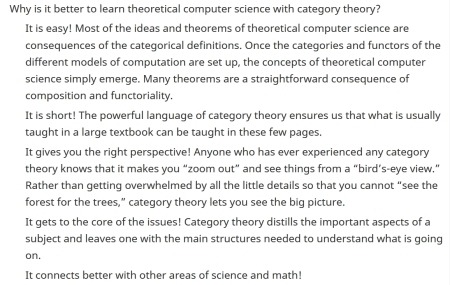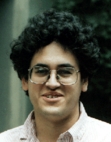John C. Baez's Blog, page 25
March 4, 2022
Topos Institute Research Associates
Come spend the summer at the Topos Institute! For early-career researchers, we’re excited to open up applications for our summer research associate (RA) program.
Summer RAs are an important part of life at Topos — they help explore new directions relevant to Topos projects, and they bring new ideas, energy, and expertise to our research groups. This year we’ll welcome a new cohort of RAs to our offices in Berkeley, CA, with the program running from June to August.
RAs will be responsible for per...
February 25, 2022
Applied Category Theory 2022
The Fifth International Conference on Applied Category Theory, ACT2022, will take place at the University of Strathclyde from 18 to 22 July 2022, preceded by the Adjoint School 2022 from 11 to 15 July. This conference follows previous events at Cambridge (UK), Cambridge (MA), Oxford and Leiden.
Applied category theory is important to a growing community of researchers who study computer science, logic, engineering, physics, biology, chemistry, social sciences, linguistics and other subjects usin...
February 17, 2022
Categories: the Mathematics of Connection
I gave this talk at Mathematics of Collective Intelligence, a workshop organized by Jacob Foster at UCLA’s Institute of Pure and Applied Mathematics, or IPAM for short. There have been a lot of great talks here, all available online.
Perhaps the main interesting thing about this talk is that I sketch some work happening at the Topos Institute where we are using techniques from category theory to design epidemiological models:
• Categories: the mathematics of connection
Abstract. As we move fro...
February 14, 2022
Compositional Thermostatics (Part 3)
guest post by Owen Lynch
This is the third part (part 1, part 2) of a blog series on a paper that we wrote recently:
• John Baez, Owen Lynch and Joe Moeller, Compositional thermostatics.
In the previous two posts we talked about what a thermostatic system was, and how we think about composing them. In this post, we are going to back up from thermostatic systems a little bit, and talk about operads: a general framework for composing things! But we will not yet discuss how t...
February 7, 2022
Compositional Thermostatics (Part 2)
guest post by Owen Lynch
In Part 1, John talked about a paper that we wrote recently:
• John Baez, Owen Lynch and Joe Moeller, Compositional thermostatics.
and he gave an overview of what a ‘thermostatic system’ is.
In this post, I want to talk about how to compose thermostatic systems. We will not yet use category theory, saving that for another post; instead we will give a ‘nuts-and-bolts’ approach, based on examples.
Suppose that we have two thermostatic systems and we put them in thermal con...
February 3, 2022
Submission to arXiv
guest post by Phillip Helbig
Monthly Notices of the Royal Astronomical Society is one of the oldest and most prestigious journals in the fields of astronomy, astrophysics, and cosmology. My latest MNRAS paper was not allowed to appear in the astro-ph category at the arXiv (https://arxiv.org, the main avenue of distribution for scientific articles in many fields) because it was reclassified to a category which is inappropriate for several reasons. This is definitely not due to some technical er...
January 30, 2022
Hardy, Ramanujan and Taxi No. 1729
In his book Ramanujan: Twelve Lectures on Subjects Suggested by His Life and Work, G. H. Hardy tells this famous story:
He could remember the idiosyncracies of numbers in an almost uncanny way. It was Littlewood who said every positive integer was one of Ramanujan’s personal friends. I remember once going to see him when he was lying ill at Putney. I had ridden in taxi-cab No. 1729, and remarked that the number seemed to be rather a dull one, and that I hoped it was not an unfavourable omen...
January 26, 2022
The Kepler Problem (Part 4)
The Kepler problem is the study of a particle moving in an attractive inverse square force. In classical mechanics, this problem shows up when you study the motion of a planet around the Sun in the Solar System. In quantum mechanics, it shows up when you study the motion of an electron around a proton in a hydrogen atom.
In Part 2 we saw that the classical Kepler problem has, besides energy and the three components of angular momentum, three more conserved quantities: the components of the ecc...
Learning Computer Science With Categories
The first book in Bob Coecke’s series on applied category theory is out, and the pdf is free—legally, even!—until 8 February 2022. Grab a copy now:
• Noson Yanofsky, Theoretical Computer Science for the Working Category Theorist, Cambridge U. Press, 2022.
There are already books on category theory for theoretical computer scientists. Why the reverse? Yanofsky explains:
There’s just one catch: you need to know category theory.
But it’s worth learning category theory, because it’s like a ma...
January 25, 2022
Categories in Chemistry, Computing, and Social Networks
This article does two things:
• John Baez, Simon Cho, Daniel Cicala, Nina Otter, and Valeria de Paiva, Applied category theory in chemistry, computing, and social networks, Notices of the American Mathematical Society, February 2022.
It urges you — or your friends, or students — to apply for our free summer school in applied category theory run by the American Mathematical Society. It’s also a quick intro to some key ideas in applied category theory!
Applications are due Tuesday 2022 February...
John C. Baez's Blog
- John C. Baez's profile
- 29 followers





